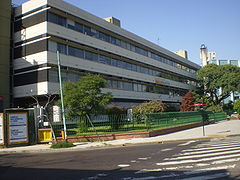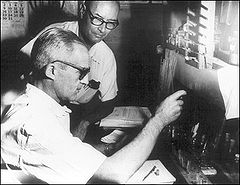
Leloir Institute
Encyclopedia

Buenos Aires
Buenos Aires is the capital and largest city of Argentina, and the second-largest metropolitan area in South America, after São Paulo. It is located on the western shore of the estuary of the Río de la Plata, on the southeastern coast of the South American continent...
specializing in biotechnology
Biotechnology
Biotechnology is a field of applied biology that involves the use of living organisms and bioprocesses in engineering, technology, medicine and other fields requiring bioproducts. Biotechnology also utilizes these products for manufacturing purpose...
, including biochemistry
Biochemistry
Biochemistry, sometimes called biological chemistry, is the study of chemical processes in living organisms, including, but not limited to, living matter. Biochemistry governs all living organisms and living processes...
, cellular biology, molecular biology
Molecular biology
Molecular biology is the branch of biology that deals with the molecular basis of biological activity. This field overlaps with other areas of biology and chemistry, particularly genetics and biochemistry...
, and related activities.
Overview
The research center was inaugurated in 1947 by way of an initiative of University of Buenos AiresUniversity of Buenos Aires
The University of Buenos Aires is the largest university in Argentina and the largest university by enrollment in Latin America. Founded on August 12, 1821 in the city of Buenos Aires, it consists of 13 faculties, 6 hospitals, 10 museums and is linked to 4 high schools: Colegio Nacional de Buenos...
Physiology Professors Bernardo Houssay
Bernardo Houssay
-External links:* * . WhoNamedIt.* . Nobel Foundation....
and Luis Leloir. The project was funded by the philanthropic support of local textile industrialist Jaime Campomar, and Dr. Houssay devoted a share of the proceeds from the Nobel Prize in Physiology he earned that year to the establishment of the institute. Initially located in a belle époque
Belle Époque
The Belle Époque or La Belle Époque was a period in European social history that began during the late 19th century and lasted until World War I. Occurring during the era of the French Third Republic and the German Empire, it was a period characterised by optimism and new technological and medical...
building in the Palermo
Palermo, Buenos Aires
Palermo is a neighborhood, or barrio of the Argentine capital, Buenos Aires. It is located in the northeast of the city, bordering the barrios of Belgrano to the north, Almagro and Recoleta to the south, Villa Crespo and Colegiales to the west and the Río de la Plata river to the east. With a total...
section of Buenos Aires, the institute was first directed by Dr. Leloir and, following Campomar's death in 1956, it became a recipient of an endowment from both the Rockefeller Institute and the National Institutes of Health
National Institutes of Health
The National Institutes of Health are an agency of the United States Department of Health and Human Services and are the primary agency of the United States government responsible for biomedical and health-related research. Its science and engineering counterpart is the National Science Foundation...
, both in the United States
United States
The United States of America is a federal constitutional republic comprising fifty states and a federal district...
. The institute was formally named the Campomar Institute of Research in Biochemistry in 1958, when it was relocated to a utilitarian building belonging to the city's health ministry in the Belgrano
Belgrano, Buenos Aires
Belgrano is a leafy, northern barrio or neighborhood of the city of Buenos Aires, Argentina.- Location :The barrio of Palermo is to the southeast; Nuñez is to the northwest; Coghlan, Villa Urquiza, Villa Ortúzar and Colegiales are to the southwest....
section, nearby.

Nucleotide
Nucleotides are molecules that, when joined together, make up the structural units of RNA and DNA. In addition, nucleotides participate in cellular signaling , and are incorporated into important cofactors of enzymatic reactions...
s and their role in human metabolic pathway
Metabolic pathway
In biochemistry, metabolic pathways are series of chemical reactions occurring within a cell. In each pathway, a principal chemical is modified by a series of chemical reactions. Enzymes catalyze these reactions, and often require dietary minerals, vitamins, and other cofactors in order to function...
s earned him the 1970 Nobel Prize in Physiology. This became known as “Leloir's pathway” and was a significant advance for biochemistry
Biochemistry
Biochemistry, sometimes called biological chemistry, is the study of chemical processes in living organisms, including, but not limited to, living matter. Biochemistry governs all living organisms and living processes...
. As a consequence of this 1957 discovery, the cause of a congenital disease called galactosemia
Galactosemia
Galactosemia is a rare genetic metabolic disorder that affects an individual's ability to metabolize the sugar galactose properly. Although the sugar lactose can metabolize to galactose, galactosemia is not related to and should not be confused with lactose intolerance...
was first identified; not detected in time, it can cause mental retardation, cataracts and cirrhosis. Numerous other colleagues of his at the institute became well-known in their fields, as well. These have included Enrico Cabib, Carlos Cardini, Ranwell Caputto, Alejandro Paladini, and Raúl Trucco, among others. The continued support of the Campomar Foundation allowed the institute to relocate to its current facilities in 1983.
Located in the Caballito
Caballito, Buenos Aires
Caballito is a barrio of the Argentine capital, Buenos Aires. It is the only barrio in the administrative division Comuna 6....
section of the city and facing Parque Centenario
Parque Centenario
Parque Centenario is an extensive public park in the Caballito district of Buenos Aires, Argentina.-Overview:Presiding over a rapidly expanding city, the Buenos Aires City Council in 1908 approved the purchase of a 10 hectare plot belonging to Parmenio Piñero, a local brickmaker, for the purpose...
, the new facilities total over 6,900 m² (74,000 ft²) and include laboratories, teaching facilities, an auditorium and the National Biochemistry Reference Library. It was renamed the Leloir Institute in recognition of its longtime director (who died in 1987), in 2001. That year, the center initiated its program of "repatriation of researchers," in a bid to both incorporate new scientific staff, as well as to help reverse the long-standing brain drain
Brain drain
Human capital flight, more commonly referred to as "brain drain", is the large-scale emigration of a large group of individuals with technical skills or knowledge. The reasons usually include two aspects which respectively come from countries and individuals...
suffered by the Argentine scientific community.
The center maintains numerous cooperation agreements with not only prominent local research centers such as the CONICET and University of Buenos Aires
University of Buenos Aires
The University of Buenos Aires is the largest university in Argentina and the largest university by enrollment in Latin America. Founded on August 12, 1821 in the city of Buenos Aires, it consists of 13 faculties, 6 hospitals, 10 museums and is linked to 4 high schools: Colegio Nacional de Buenos...
School of Exact Sciences; but also respected international centers, such as Partners Harvard Medical International
Partners Harvard Medical International
Partners Harvard Medical International is a not-for-profit organization that provides advisory services and professional consulting to organizations outside the United States. PHMI is a subsidiary of Partners HealthCare System, a health care system based in Boston, Massachusetts.-History:PHMI was...
, the Howard Hughes Medical Institute
Howard Hughes Medical Institute
Howard Hughes Medical Institute is a United States non-profit medical research organization based in Chevy Chase, Maryland. It was founded by the American businessman Howard Hughes in 1953. It is one of the largest private funding organizations for biological and medical research in the United...
, INIS Biotech, and the Weizmann Institute. It hosts 24 research teams and 170 scientists, whose varied specialties include neuroscience
Neuroscience
Neuroscience is the scientific study of the nervous system. Traditionally, neuroscience has been seen as a branch of biology. However, it is currently an interdisciplinary science that collaborates with other fields such as chemistry, computer science, engineering, linguistics, mathematics,...
, cellular biology, oncology
Oncology
Oncology is a branch of medicine that deals with cancer...
, gene therapy
Gene therapy
Gene therapy is the insertion, alteration, or removal of genes within an individual's cells and biological tissues to treat disease. It is a technique for correcting defective genes that are responsible for disease development...
, epidemiology
Epidemiology
Epidemiology is the study of health-event, health-characteristic, or health-determinant patterns in a population. It is the cornerstone method of public health research, and helps inform policy decisions and evidence-based medicine by identifying risk factors for disease and targets for preventive...
and biotechnology
Biotechnology
Biotechnology is a field of applied biology that involves the use of living organisms and bioprocesses in engineering, technology, medicine and other fields requiring bioproducts. Biotechnology also utilizes these products for manufacturing purpose...
; among its associated fellows is the recipient of 1984 Nobel Prize in Physiology, Dr. César Milstein
César Milstein
César Milstein FRS was an Argentine biochemist in the field of antibody research. Milstein shared the Nobel Prize in Physiology or Medicine in 1984 with Niels K. Jerne and Georges Köhler.-Biography:...
. Construction started on the institute's new annex in 2007, consisting of 2,900 m² (31,000 ft²) of space for imaging, as well as for expanded research on cell cultures and biophysics. These investments continue the Leloir Institute's tradition as a leader in science and technology in Argentina
Science and technology in Argentina
The most important aspects of science and technology in Argentina are concerned with medicine, nuclear physics, biotechnology, nanotechnology, space and rocket technology and several fields related to the country's main economic activities....
.

